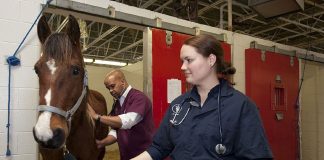A: Shivers is a problem related to neurologic and muscular tissues, and is often associated with the muscle disease equine polysaccharide storage myopathy (EPSSM). A horse with shivers demonstrates a noticeable abnormal hind limb action. The horse hikes a hind limb upward and outward in an exaggerated fashion; this odd posture persists for seconds up to minutes, and is often triggered when the limb is elevated for examination or for shoeing. All the while the limb trembles or “shivers” and sometimes the tail quivers, too. It would be easy to confuse this gait abnormality with stringhalt (an abnormal gait that involves exaggerated flexion of one or both hock joints) or upward fixation of the patella (locking stifle). But rather than persisting with every step as you’d see with stringhalt, the abnormal limb movement in shivers horses appears sporadically. An affected horse typically experiences the odd gait just as he departs into a walk, or as he makes the transition to stop, or if he is asked to back or is circled tightly.
Certain situations, like restricted exercise and confinement, anxiety, or inclement weather, may bring out the worst of the classic clinical signs. Researchers believe shivers is a progressively degenerating ailment. Because of its slow development, severe clinical signs may not appear for as long as a decade, although a slight gait abnormality may be observed early in an affected horse’s life.
There is no cure for shivers. The best an owner can hope for is to slow the disease process for as long as possible. The optimal approach is to follow the same dietary strategy used to manage EPSSM horses, which is based on a hay/pasture diet that includes a fat supplement low in starch and sugar—grain should be eliminated from the diet.
Nancy S. Loving, DVM, is a performance horse veterinarian based in Boulder, Colo. She is also the author of All Horse Systems Go.







Thanks for info!! I enjoy going through the veterinary question/answers to learn new things everyday about horses. Its great!
I have a 16 yr old TWH and he was recently diagnosed with shivers. His symptoms were just as described but now is a lot worse. In a 6 month period he now has trouble walking forward, he will not back up, trot, or run around the pasture with the other horses. He also buckles his hind fetlocks when asked to trot. Why can’t someone find out something to cure this disease? I am keeping a close eye on him but I am still praying for a miracle. There is a video on YouTube called “Oreo with Shivers” if anyone would like to see what I’m talking about. Keep in mind this is the way he is now, it was not that bad in the beginning.